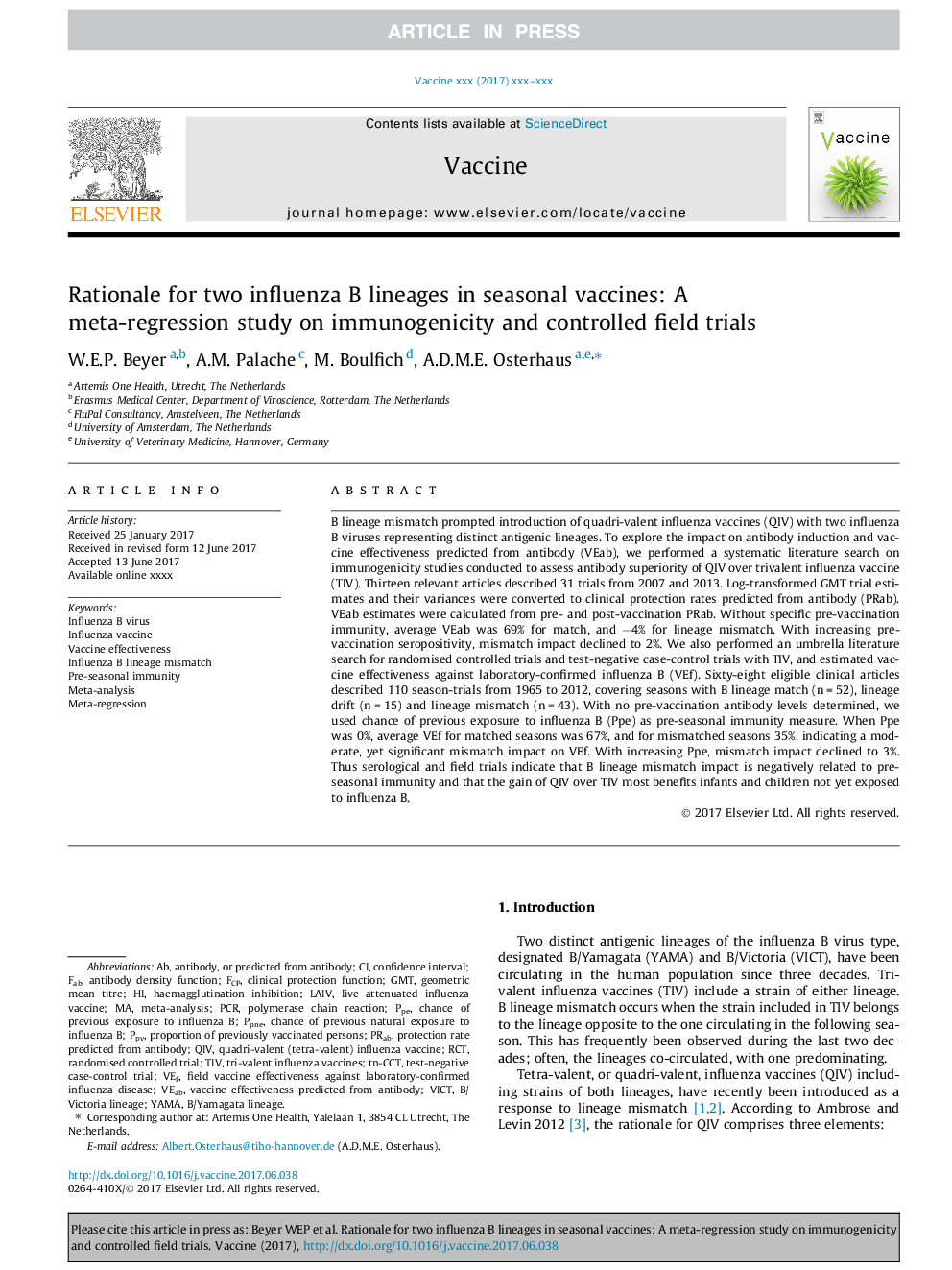| کد مقاله | کد نشریه | سال انتشار | مقاله انگلیسی | نسخه تمام متن |
|---|---|---|---|---|
| 5536438 | 1402289 | 2017 | 10 صفحه PDF | دانلود رایگان |
عنوان انگلیسی مقاله ISI
Rationale for two influenza B lineages in seasonal vaccines: A meta-regression study on immunogenicity and controlled field trials
دانلود مقاله + سفارش ترجمه
دانلود مقاله ISI انگلیسی
رایگان برای ایرانیان
کلمات کلیدی
QIVVEFFCPLAIVPPVGMTPPETIVRCTRandomised controlled trial - آزمایش تصادفی کنترل شدهVaccine effectiveness - اثربخشی واکسنMeta-regression - رگرسیون متا ریاضیFab - فابconfidence interval - فاصله اطمینانMeta-analysis - فرا تحلیل haemagglutination inhibition - مهار hemagglutinationGeometric mean titre - میانگین تیتر هندسیinfluenza vaccine - واکسن آنفلوآنزاlive attenuated influenza vaccine - واکسن آنفولانزای انسدادی زندهpolymerase chain reaction - واکنش زنجیره ای پلیمرازPCR - واکنش زنجیرهٔ پلیمرازInfluenza B virus - ویروس آنفلوانزای B
موضوعات مرتبط
علوم زیستی و بیوفناوری
ایمنی شناسی و میکروب شناسی
ایمونولوژی
پیش نمایش صفحه اول مقاله

چکیده انگلیسی
B lineage mismatch prompted introduction of quadri-valent influenza vaccines (QIV) with two influenza B viruses representing distinct antigenic lineages. To explore the impact on antibody induction and vaccine effectiveness predicted from antibody (VEab), we performed a systematic literature search on immunogenicity studies conducted to assess antibody superiority of QIV over trivalent influenza vaccine (TIV). Thirteen relevant articles described 31 trials from 2007 and 2013. Log-transformed GMT trial estimates and their variances were converted to clinical protection rates predicted from antibody (PRab). VEab estimates were calculated from pre- and post-vaccination PRab. Without specific pre-vaccination immunity, average VEab was 69% for match, and â4% for lineage mismatch. With increasing pre-vaccination seropositivity, mismatch impact declined to 2%. We also performed an umbrella literature search for randomised controlled trials and test-negative case-control trials with TIV, and estimated vaccine effectiveness against laboratory-confirmed influenza B (VEf). Sixty-eight eligible clinical articles described 110 season-trials from 1965 to 2012, covering seasons with B lineage match (n = 52), lineage drift (n = 15) and lineage mismatch (n = 43). With no pre-vaccination antibody levels determined, we used chance of previous exposure to influenza B (Ppe) as pre-seasonal immunity measure. When Ppe was 0%, average VEf for matched seasons was 67%, and for mismatched seasons 35%, indicating a moderate, yet significant mismatch impact on VEf. With increasing Ppe, mismatch impact declined to 3%. Thus serological and field trials indicate that B lineage mismatch impact is negatively related to pre-seasonal immunity and that the gain of QIV over TIV most benefits infants and children not yet exposed to influenza B.
ناشر
Database: Elsevier - ScienceDirect (ساینس دایرکت)
Journal: Vaccine - Volume 35, Issue 33, 24 July 2017, Pages 4167-4176
Journal: Vaccine - Volume 35, Issue 33, 24 July 2017, Pages 4167-4176
نویسندگان
W.E.P. Beyer, A.M. Palache, M. Boulfich, A.D.M.E. Osterhaus,